
scrounge: /skrounj/ informal verb: to actively seek [books] from any available source
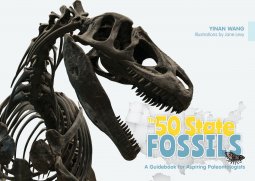
We enjoy reading about dinosaurs and fossils around here, so I found The 50 State Fossils: A Guidebook for Aspiring Paleontologists not only a great introduction to fossils, but also a unique viewpoint on American geography. Since fossils are found all over the world, it's sometimes hard to remember which dinosaurs roamed when and where, etc. This book helps to give fossils a distinctly American context.
Of course, while dinosaurs are probably the most famous and cool fossils out there, the general category of "fossils" involves a lot more: mammoths and other ancient mammals, plants, shells, footprints, and more. It was interesting to read about which kinds of fossils are more common in which states. For the few states that do not yet have an official state fossil or dinosaur, the book gives a brief history of attempts as well as a suggestion or two of what might make a good choice. I really had no idea what my state's fossil was, so I appreciated getting the chance to read more about it (pertica -- a unique plant).
There is a page here for each state, which includes the fossil name, scientific name, time period, a couple illustrations and/or photos, and a several-paragraph description. The beginning of the book gives some information about how fossilization occurs, time periods, etc., while the end of the book includes a glossary and also a list of places (such as museums), per state, where you can visit to see fossils. Very cool and informative!
(Thanks to NetGalley for the review copy.)
Scrounged From: NetGalley
Format: Kindle
Author: Yinan Wang
Illustrator: Jane Levy
Pages: 64
Content Advisory: None
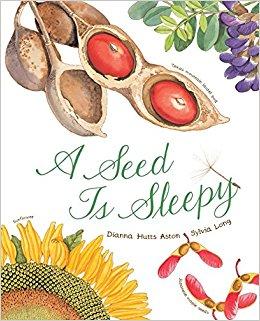
A Seed Is Sleepy is a wonderful nonfiction picture book that introduces children to the wonder of seeds. The illustrations are detailed and colorful, and the text manages to include important information in a way that is meditative and celebratory, without becoming too wordy or clinical.
The book covers seeds of all different sizes and types, and emphasizes the different ways seeds find to spread themselves out in order to germinate in new places. The process of germination is covered as well, and one of the most fascinating parts was a page that mentioned a seed from an extinct date palm tree that germinated after being preseved for over one thousand years!
Even though the book is poetic and quick to read, I still came away from it feeling like a lot of aspects of seeds had been covered, and was impressed again at the utter variety of seeds in the world. I'm looking forward to reading more from this series.
Scrounged From: Amazon
Format: Paperback
Author: Dianna Aston
Illustrator: Sylvia Long
Pages: 40
Content Advisory: None
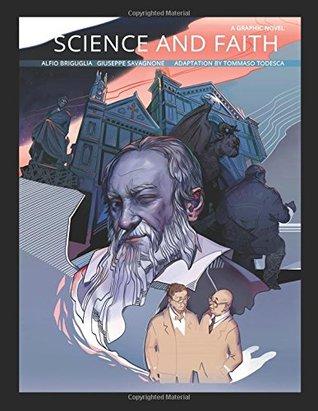
I'm not usually a graphic novel fan, but I've found that they can be an engaging means of entering into a story, or discovering something new. And since faith has always been a part of my life, I was intrigued to learn about a graphic novel that takes on the relationship between science and faith, called, appropriately, Science and Faith.
I've seen firsthand the antagonism that can arise when science and faith are discussed together, especially from people holding very different viewpoints on one subject or the other (and I have to include myself in this observation!). I don't get the impression that this book is out to specifically change anyone's mind about their particular view (and probably many people will not agree with every view put forward here), but it does have the potential to make us think, as well as simply to give us an appreciation of some of the scientists and theologians (and some who were both) who have helped shape this conversation over the last several hundred years.
Our fellow travelers on this journey are two real-life professors: Alfio Briguglia and Giuseppe Savagnone, who have been friends for more than seventy years. After they co-wrote a book about science and faith in Italy, Tommaso Todesca wanted to adapt it into a graphic novel -- and here it is. Alfio and Giuseppe encounter many of the greatest minds in history (most long since deceased), and their journey takes them all over Florence and London as they converse with these renowned historical figures.
Kepler, Galileo, Newton, Darwin, and others make an appearance here, as well as both Richard Dawkins and Saint Thomas Aquinas in the last section, which covers the concept of God. Don't worry -- this is no Bill and Ted's Excellent Adventure. Despite the fantastical premise, the questions and quandaries discussed and mused upon here are sincere, earnest, and will probably leave the reader with much to ponder, regardless of their exact viewpoint going in.
I appreciate that the individual characters depicted here do not always agree with each other -- Dawkins especially stands in quite obvious opposition to the religious viewpoints expressed by most others in the book, and yet his "outsider's perspective" is important to prevent this exploration from becoming too inwardly focused. While the two characters don't actually meet here (each says his piece separately) this is probably the next best thing to actually watching a (sadly impossible) debate between Richard Dawkins and Saint Thomas Aquinas.
Even though I'm Protestant, I could still appreciate the Catholic perspective here, because I do think it helps tie in the history of these great thinkers (most of whom were also Catholic) to the present day, and the questions pondered here are really for all Christians to consider, no matter where we may stand on other issues.
Aside from the discussion, the artwork here is really lovely -- nothing cheap or cartoony about it -- the landscapes draw you in, and it's easy to feel that you really are just strolling down the road in Florence or London, conversing with a long-dead ghost. I'm sure anyone who's interested in history has fantasized about getting to meet their favorite historical figures, and the more I read here, the more I saw how well the graphic novel format really does work for this -- it helps give each character their own presence and personality (I found Galileo particularly amusing), even in the short time that some of them are featured.
One of the parts that resonated with me personally was the beginning discussion in section 2, which focuses on the terms we use -- it counters the idea that faith is by definition devoid of reason, and quotes Pope John Paul II as saying, "...faith and reason cannot be split! They are like the two wings with which the human spirit rises up towards the contemplation of truth." The ending was also pretty neat, and a bit surreal. I really should read Dante sometime.
All in all, I found this book both enjoyable and intriguing, and I'd recommend it to any science/faith geek, and probably those interested in philosophy in general. While the book doesn't go into great depth or detail on any of these historical figures (there really isn't room), it's a nice introduction to many topics and controversies in the science/faith discussion, and clearly comes down with the view that yes, science and faith can and do coexist quite well.
Scrounged From: A gift
Format: Paperback
Authors: Giuseppe Savagnone, Alfio Briguglia, this edition adapted by Tommaso Todesca
Illustrator: Alexandra Festovets
Pages: 142
Content Advisory: In the fourth section, "the problem of evil" is occasionally illustrated by some images of demons/devils which may be disturbing to some children.
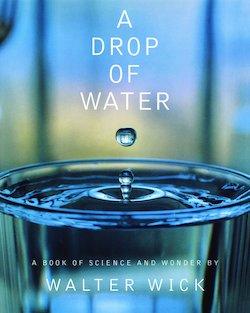
Most will know Walter Wick as the amazing photographer behind the I Spy series, as well as Can You See What I See?
After looking at many of these books full of intricate, cluttered images, the photographs in A Drop of Water are quite a contrast with their simplicity, portrayal of motion, and more minimalist approach.
This book is a fascinating photographic exploration of many of the different properties and actions of water: freezing and melting, surface tension, evaporation and condensation, diffusion, frost and dew, refraction, and more. The photographs of the falling drops of water are particularly interesting, but there are also photos to illustrate the other concepts, including bubbles, steam, snowflakes, etc.
While the text tends to focus on the smaller and more easily observable aspects of water, there is a little bit of "big picture" information as well, such as a brief description of the water cycle. This would be a great science supplement for elementary-age students and older. Even though the text was a bit wordy for my kindergartener (though it's not excessively so), we still very much enjoyed the photographs, and were even inspired to try an experiment after seeing the pictures of a drop of blue food coloring gradually diffusing through a glass of clear water.
Scrounged From: Our local library
Format: Hardcover
Author/Illustrator: Walter Wick
Pages: 40
Content Advisory: None
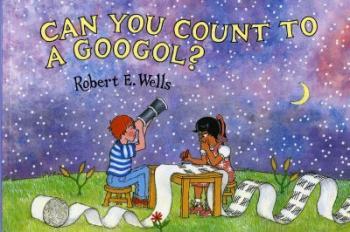
A while ago, in this post, I wrote about some titles in Robert E. Wells' science series that we've really enjoyed. We've since read a few more books from this series that we've enjoyed just as much, so I decided we needed a "part two."
The first is Can You Count to a Googol?, which uses creative illustrations and simple mathematical concepts to introduce students to progressively larger numbers -- from one, to ten, to one hundred (with the reminder that each zero at the end makes a number ten times bigger), to even more. The visualizations include baskets full of marshmallows, penguins eating many scoops of ice cream, and dollar bills packed onto pallets. The end blew our minds a bit as we tried to understand just how big a googol is (one with one hundred zeroes after it). Even then, the reminder that numbers never end gives a lot of perspective as we contemplate outer space and other things so much bigger than us. This book is similar to How Much Is a Million?, a memorable Reading Rainbow book, but I appreciate that this one walks us through even larger numbers and is more clear about how to get from one to another.
The next is Did a Dinosaur Drink This Water?, which is a very thorough exploration of the water system (dinosaur-loving kids may be disappointed to find out that this isn't really about dinosaurs, but it does emphasize how water molecules have been recycled over and over for a very long time). Since it mentions water molecules, this might be an interesting follow-up to What's Smaller Than a Pygmy Shrew? It covers fresh vs. salt water, how water is naturally cleaned and filtered, evaporation and rain, hydroelectricity, and also a bit about conservation at the end, which actually follows well from the text and doesn't feel "tacked on" like these things sometimes do.
Lastly, we've also enjoyed How Do You Know What Time It Is?, which is one of the more thorough titles we've read since it covers aspects of both science and history, and it may be harder for younger children to follow. But it does a great job introducting children to the concept of time, and how we don't even really know what it is. The history comes in when it discusses many of the earlier methods that people used to measure time, such as sun dials, water clocks, and solar vs. lunar calendars. From there it goes into earth's rotation and orbit, as well as time zones and other complications of measuring time. I appreciated the science and history, but also the straightforwardness about mystery, and how much science still hasn't been able to tell us about many concepts, such as time.
Scrounged From: Our local library and AbeBooks.com

